October 13, 2022: Crowley’s Yacht Yard to Hammond Marina to DuSable Harbor, Chicago, IL.
I had the boat put in at Crowley’s Yacht Yard on October 11, 2022, the day it arrived from its cross country drive. You can read all about the process of getting the boat shipped halfway across the country in two blog posts: one about planning and one about the actual move. The folks at Crowley’s very kindly allowed me to stay at one of their docks where I had a power hookup but not much more. I had a rental car for the two days I was there and did some provisioning, mostly after picking up my friend Janet, who was joining me for the first three weeks of the trip. I returned the rental car on Wednesday afternoon and we were ready to head out on Thursday morning.
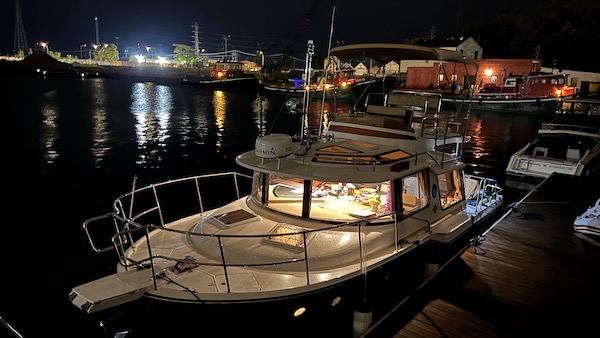
At Crowley’s at night. Technically, the dock was in a large ship turnaround area. There were three tugboats stationed behind me.
Crowley’s to Hammond
I settled my bill at Crowley’s after buying a pair of new dock lines that I sorely needed. (Because I’ll be cruising solo for a lot of this trip, I want a full complement of dock lines and fenders on both sides of the boat.) Then we headed down to the boat and cast off. In only a few minutes, we were headed down (up?) the Calumet River toward Lake Michigan.
I have to mention here that I felt absolutely exhilarated sitting on the command bridge of my boat with my pups and a good friend on a gorgeous (but windy) day as we headed under the first bridge and out toward Lake Michigan. I had accomplished a personal goal — getting my own boat and putting it on the Loop — and was starting a new adventure. How else could I feel?
The boat needed fuel. I honestly had no idea how much fuel was on board, mostly because the Volvo fuel gauge wasn’t registering a realistic number and the Garmin fuel gauge was off due to some communication issues I’d resolved after my last fueling. (Long story there.) In any case, I wanted to start the trip with full fuel tanks. Neither Crowley’s or DuSable (my destination) had fuel so I had to stop somewhere else.
Someone recommended Hammond Marina, which was in the opposite direction from where I needed to go by about 3 miles. I was told fuel was $1/gallon cheaper and if you’re buying perhaps 100 gallons of fuel, that makes a huge difference. So we went to Hammond.
It was a nice day and an easy cruise inside an empty harbor protected by a breakwater wall with two openings. The water had a light chop in the wind. We stayed up on the command bridge, bundled up in layers of clothing.
I follow @BoatUS on Twitter and they recently asked followers how many states they’d boated in. I surprised myself with the answer: New Jersey, New York, Connecticut, Virginia, North Carolina, South Carolina, Florida, Arizona, California, Utah, Nevada, Washington, Ohio, Michigan, and Pennsylvania. As of October 13, I can add Indiana and Illinois.
I let the chartplotter(s) guide me to Hammond, which was behind a larger breakwater wall. We came in slowly and found a long fuel dock. A very large boat was tied up about 2/3 in from our end. I came in a little ways behind him. Janet worked with one of the two fuel dock hands — both young women — to tie us up right by a pump. It was nice having someone handle tying up the boat instead of having to rush down from the command bridge to do it myself.
We had a port side tie and my fuel port is on the starboard side so I ran the hose across the back deck and fueled it up. It went in slowly — the dockhand told me it only pumps 10 gallons per minute on purpose. I assume that’s to avoid spills. When it started glugging, I immediately stopped pumping. A bit of fuel came out of the breather port but there was nothing I could do to stop it.
I paid in the shack on the dock. I’d taken 63 gallons, which was less than the 80+ I expected. Fuel was $5.099/gallon. Ouch.
We didn’t waste any time getting underway again. The dockhands handed off the ropes and pushed us off. I steered us out and around the breakwater at idle forward speed and pointed the boat toward Chicago.
Hammond to DuSable
I decided to experiment with the autorouting feature of my autopilot and told it I wanted to go to DuSable Harbor. It calculated a route that would get me out into Lake Michigan a lot sooner than I wanted to be out of the protected harbor. So I canceled the chartplotter and used heading hold to steer to the gap in the breakwater I wanted. From there, I tried the autoroute feature again and got the route I wanted. (Yes, I could have just edited the original route, but I’m taking baby steps as I learn and use the boat’s systems.) I let it drive the boat right up to the turn into the Harbor, which lay beyond another breakwater.
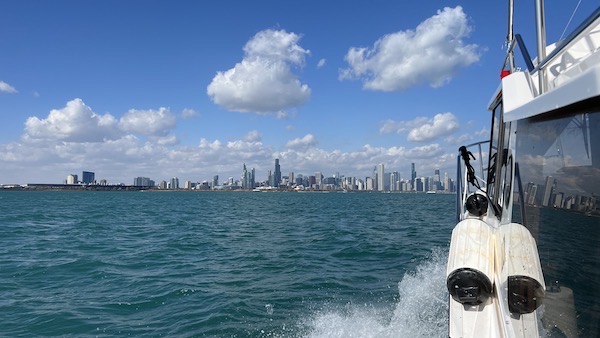
A shot from the port side looking out across Lake Michigan toward Chicago.
The water was choppy but not exactly rough. The wind was really blowing, though, and it was cold. Still, we stayed up top on the command bridge for the ride, which took about an hour. We cruised at about 10 knots most of the way. I was glad to make the turn into the breakwater, where I shut off the autopilot. The water was much calmer in there and there was a lot less wind at just 5 knots.
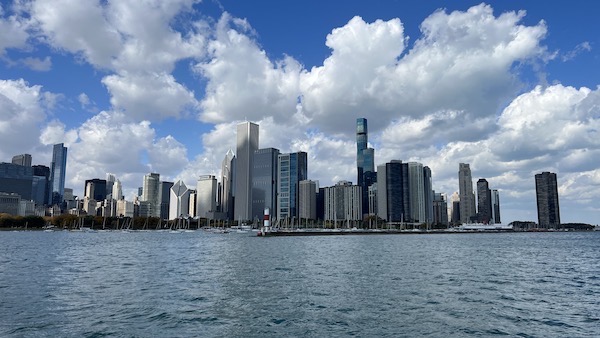
The end of the breakwater around DuSable Harbor. The water on the other side was much calmer. The marina is to the right, past that large white boat.
As far as location goes, DuSable Harbor is probably the best marina for boaters visiting Chicago — although your boat better be 30 feet or larger if you want a slip. I reserved through Dockwa, which is a marina reservation app. I decided we’d stay two nights and spend the full middle day walking around the city. The dock fees with 30 amp power and taxes came to about $190 total.
I originally requested a bow in starboard tie since that’s what I prefer when traveling alone. The only thing they had was the end of the E dock. I realized that not only would this be a long walk back to land (and bathrooms, etc.) but it would put us in a highly trafficked area, keeping the boat in near constant motion. So I asked for something closer in with a bow in port tie. She switched us to a slip at the other end of the dock, just two slips from land.
When I got to the dock, I almost regretted it. The fairways between docked boats are a lot narrower than I’m used to and the wind was still blowing hard. But Janet was ready and when I cruised slowly down the fairway, a guy on a sailboat offered to help. Normally, I’d say no but with the wind and the tight space, I figured we could use all the help we could get.
When we got close, I saw that our neighbor across the dock was another Ranger Tug. They saw us coming and came out to help, too. But in all honesty, we really didn’t need that much help. I took it slow, considered the wind, and used the thrusters when I had to. I got about even with the slip, made a pivoting turn, and glided into it. Janet and the folks on the dock grabbed the lines before the wind could push us into the very large Carver on my starboard side. I think we were all impressed, including me.
We had arrived in downtown Chicago.

Here’s an image of my Nebo log for October 13, 2022. Download a PDF of the log with more info. Track Do It Now on Nebo.
(continued in A Stay in Chicago)
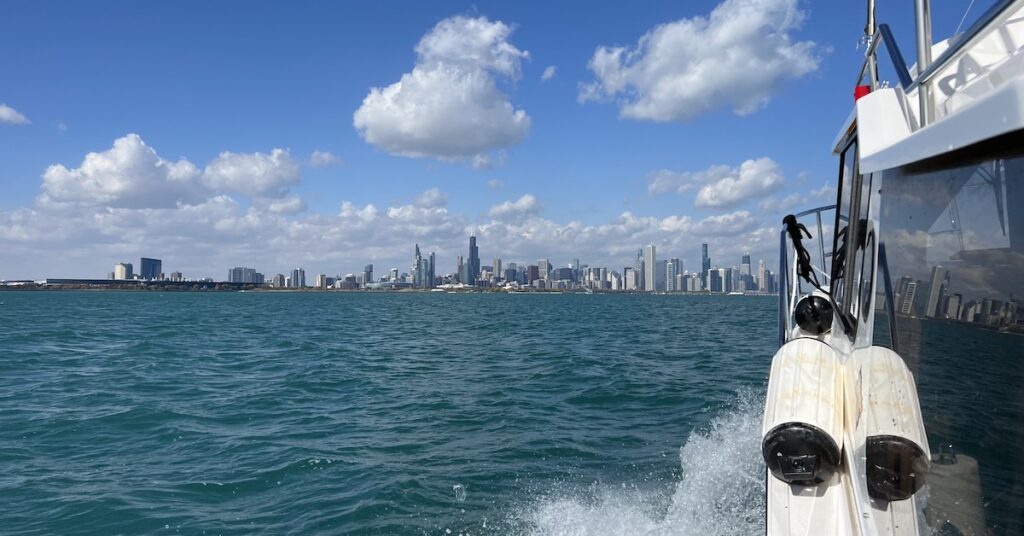
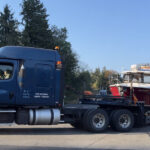

Love it!
You and me both!
OK, I’ll bite. You say “ouch” to $5.099 diesel, but you cruised at 10 knots most of the way. Why not slow down to hull speed (7.3 knots) or slightly slower and save a bunch of fuel? Performance chart for R29 shows 1600rpm gives 7.2kn at 2.0gph (3.6nmpg), 2000rpm gives 8.3kn at 3.9gph (2.1nmpg), 2600rpm gives 11.9kn at 7.5gph (1.6nmpg).
I can save even more money by parking it at a marina and not going anywhere. Or traveling at idle RPM, which gives me 3.5 knots and nearly 4 MPG. But what’s the fun in that?
I usually pick a cruise speed based on how eager I am to get to a destination. It was a windy, blustery day and we were in Lake Michigan’s chop, with water coming up over the bow occasionally. We were heading for our first real marina, which offered walking distance access to downtown Chicago. I wanted to get there within a reasonable time, so I cruised at 10 knots. I wasn’t eager enough to cruise at 14 knots, which I’ve done in the past when I had a serious case of get-there-itus.
Understand that at a Volvo seminar I attended at the Ranger Rendezvous in September, the Volvo guys said the boat likes to cruise at 80% to 90% RPM. I’m still analyzing combinations of RPM, fuel burn, and speed to determine which settings work best for me.
I’m not sure about the performance chart you’re consulting. The only one I could find for R-29s was for the newer boats with the Volvo D4 320 hp engine. I have the D4 300. I’m building my own performance chart for my boat using data from my engine and chart plotter computers and I’m not seeing those numbers. If you have a chart for a 2019 to 2021 R-29, I’d love to see it.
Feel free to quote the Volvo guys or whomever. My point may have been lost entirely: the formula for hull speed is 1.35 x ^2. If your boat was full displacement, that’d be about as fast as it could go. With the Ranger Tug being semi-displacement, fuel consumption goes up significantly as you exceed that value. Performance charts might give you specific numbers, but inevitably they’ll all follow a rough shape like a hockey stick: small upward slope to hull speed, much steeper upward slope beyond that. Happy boating!
Realized overnight I wrote the formula backwards – velocity in knots = 1.35 x square root of hull length.